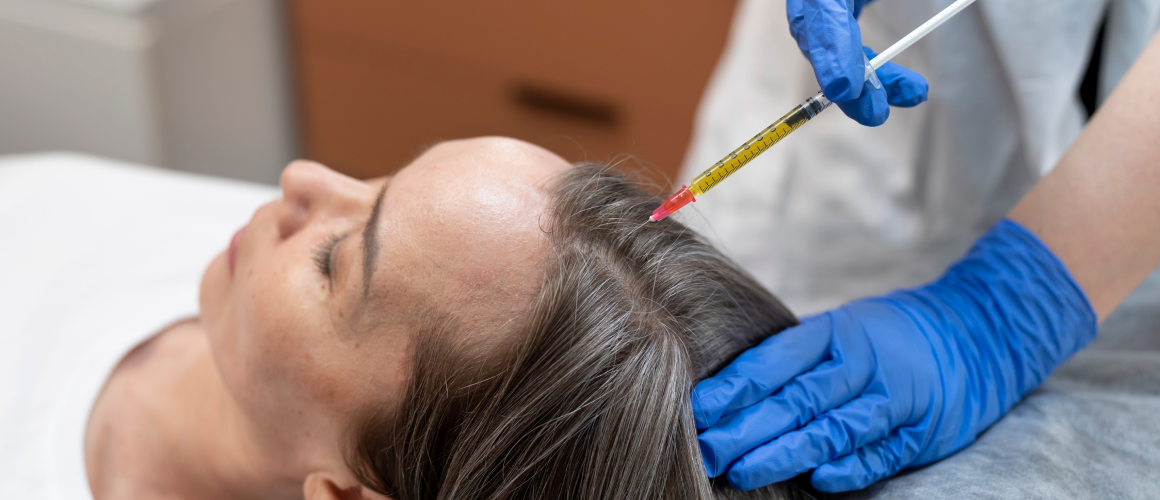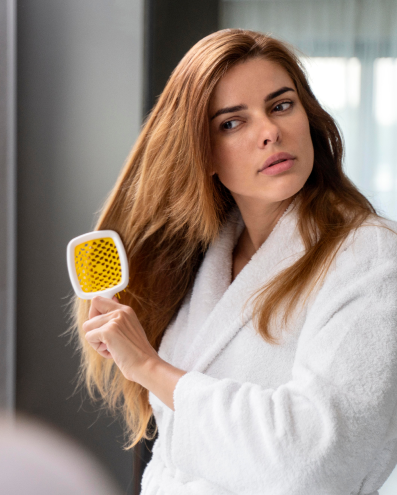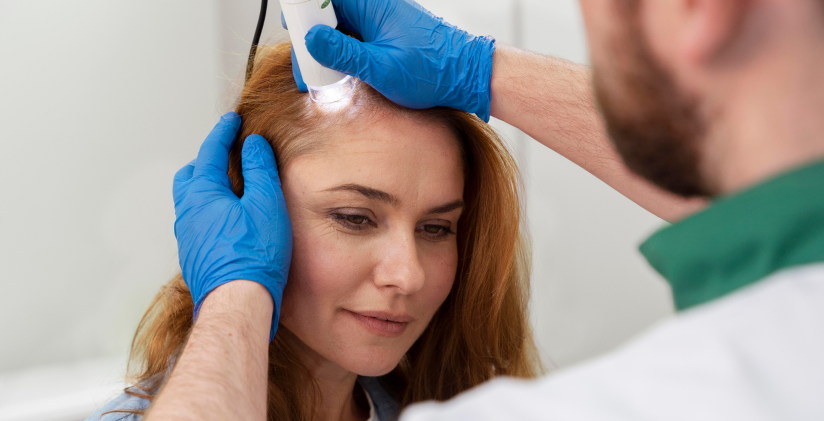How SMP Can Treat Female Hair Loss

Scalp Micropigmentation (SMP) is a non-surgical cosmetic treatment for hair loss. It makes use of needles to embed pigment into the scalp, mimicking the appearance of hair follicles. Scalp micropigmentation treatment creates an illusion of fuller, denser hair, making it an ideal solution for various types of hair loss conditions, including thinning hair, male pattern baldness and female pattern baldness, and alopecia. The SMP treatment is fast gaining popularity due to its immediate results, relative affordability, and minimal maintenance.
Understanding Female Hair Loss
Female hair loss can be categorized into several types, each characterized by specific signs, causes, and patterns:
Androgenetic Alopecia
Also known as female pattern baldness, this is the most common type of hair loss in women. It is typically characterized by thinning hair along the crown and hairline.
Telogen Effluvium
This temporary hair loss condition is often caused by stress, illness, or major life events. It results in a generalized hair thinning across the scalp.
Alopecia Areata
This is an autoimmune disorder that leads to patchy hair loss. In severe cases, it can result in complete baldness, known as alopecia totalis.
Traction Alopecia
This form of hair loss is due to constant tension or pulling on hair strands, commonly caused by certain hairstyles like tight braids or ponytails.
Anagen Effluvium
This condition involves the shedding of hair during the anagen or growth phase. It's most commonly associated with chemotherapy drugs.
Each type of hair loss presents unique challenges and may require different treatment approaches, including Scalp Micropigmentation (SMP).

Causes and Contributing Factors to Hair Loss in Women
Hair loss in women can be triggered by a variety of factors. An understanding of these factors aids in identifying appropriate treatment solutions such as Scalp micropigmentation treatment (SMP):
Genetics
Genetic predisposition plays a significant role in androgenetic alopecia, where a history of baldness on either side of the family increases the likelihood of experiencing hair loss.
Hormonal Imbalances
Changes or imbalances in hormones, often occurring during menopause, pregnancy or due to thyroid conditions, can lead to thinning hair or baldness.
Stress and Trauma
Prolonged periods of intense stress or traumatic events can result in temporary hair loss conditions like telogen effluvium.
Hairstyling and Treatment
Regular use of hairstyles that pull on the hair or harsh hair treatments can lead to traction alopecia.
Medical Conditions and Treatments
Conditions such as alopecia areata, an autoimmune disorder, or treatments like chemotherapy (anagen effluvium) can result in hair loss.
Diet and Nutrition
Insufficient intake of essential nutrients, vitamins, and minerals can affect hair health and lead to hair shedding or thinning.
By understanding the causes and contributing factors, it is possible to address female hair loss more effectively using treatments such as Scalp Micropigmentation.
Scalp Micropigmentation Procedure for Women
The Scalp Micropigmentation (SMP) procedure for women generally follows a four-step approach:
Consultation
The first step involves a detailed consultation with a trained SMP professional. This session allows the expert to understand the client's specific hair loss type, the causes, and the desired outcome. The practitioner will evaluate the client's scalp, discuss pigment shades for a natural look, and outline the expected results.
Design
The design phase involves planning the SMP application. The specialist maps the client's scalp, deciding on the areas that need SMP treatment. They also determine the density and blending required, taking into consideration any existing hair.
Application
The actual scalp micropigmentation application process begins during the third step. The practitioner uses specialized needles to embed pigment into the scalp, replicating the look of natural hair follicles. This process can take several sessions, each lasting 2-3 hours, depending on the extent of hair loss.
Follow-up
The final step involves post-treatment care and follow-ups. Clients receive instructions for maintaining their newly pigmented scalp, including advice on sun exposure and washing. A touch-up session might be scheduled a few weeks after the procedure to assess the results and make any necessary adjustments.
It is important to note that, while SMP offers a viable solution for female hair loss, results can vary from person to person based on their specific hair loss pattern and scalp condition. Always consult with a trained professional to understand if SMP is the right solution for you.

Benefits of Scalp Micropigmentation For Women
Scalp Micropigmentation (SMP) can bring numerous benefits to women experiencing hair loss. These benefits range from aesthetic improvements to psychological boosts, making this innovative procedure more than just a cosmetic treatment.
Enhanced Appearance
SMP creates the illusion of fuller, denser hair, thereby enhancing physical appearance. This can boost self-esteem and confidence, fostering a more positive self-image.
Quick Results
Unlike some hair loss treatments that require a long waiting period, scalp micropigmentation offers immediate results. After the first session, patients can notice a significant difference in their appearance.
Minimal Maintenance
SMP requires very little maintenance. After the treatment, there's no need for special hair products or routines to maintain the look of fuller hair.
Cost-Effective
Compared to ongoing expenses of hair loss medications or invasive and minimally invasive processes like hair transplant surgery, SMP is a more affordable and permanent solution. It is a one-time investment for a long-lasting result.
Safe Procedure
Scalp micropigmentation is a non-surgical procedure with minimal risks. When performed by trained professionals, it is safe and does not lead to side effects like infections or scarring.
No False Promises
Unlike some hair restoration methods, scalp micropigmentation doesn’t promise unrealistic outcomes. It provides a reliable and effective solution to give the look of denser hair.
It's important to remember that while Scalp Micropigmentation can significantly enhance appearance and boost confidence, it does not cure underlying conditions causing hair loss. Therefore, it's essential to consult with a healthcare provider to explore all available options and choose a treatment that fits your individual needs. Ultimately, SMP is more than a cosmetic treatment; it's a powerful tool that can help women regain confidence and feel more comfortable in their skin.

